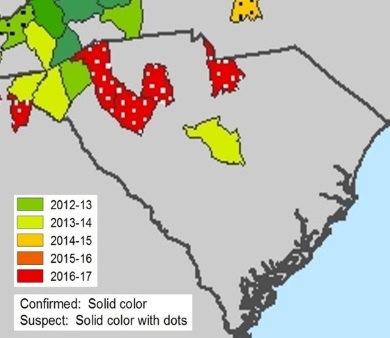DNR News
Holy Hibernation! SCDNR scientists search bat caves to combat deadly fungus January 17, 2018
by Jennifer Kindel, SCDNR Wildlife Biologist
Do you own a cave or old mine you'd be willing to have tested for white-nose syndrome (WNS) this winter? The South Carolina Department of Natural Resources (SCDNR) is conducting annual hibernating bat counts and testing bats and their "hibernacula" (places where bats hibernate) for Pseudogymnoascus destructans (Pd), the fungus that causes WNS. This fungal disease has devastated bat populations since it was first documented in New York in 2009, spreading southwest across the United States and killing over 6 million bats in North America so far.

White-nose syndrome occurrence map for South Carolina. Last Updated: 10/12/2017. Complete U.S. map available at https://www.whitenosesyndrome.org/resources/map
SCDNR scientists are interested in surveying potential hibernacula such as caves and old mines. Specific focal counties slated for additional WNS testing this year include Abbeville, Anderson, Calhoun, Cherokee, Chester, Chesterfield, Fairfield, Greenwood, Kershaw, Lexington, Newberry, Richland, Spartanburg, Sumter and York. SCDNR has been mapping the spread of the disease since it was found in Pickens County in 2013. WNS has been confirmed in Pickens, Oconee and Richland counties so far. In addition, Greenville, Union, Lancaster and Laurens counties were determined to be WNS suspect in 2017, meaning the fungus that causes the disease was present, but no clinical signs of the disease were observed on bats.
Many more South Carolina counties could potentially be harboring WNS, so with your help SCDNR can determine how far this disease has spread and monitor the survival of our beneficial bats. Bats are major consumers of insects such as mosquitoes, beetles, and other forest and agricultural pests. Not only are the 14 species of bats in SC ar an integral part of our ecosystem, they are a major contributor to our economy. According to a study in 2011 (Boyles et al.), bats provide an annual pest suppression service worth $115 million to South Carolina's agricultural industry. Nationwide, that number totals $22.9 billion nationwide. In addition to the financial benefit, the use of less pesticides also helps reduce the impact of these chemicals on many other wildlife species that call South Carolina home.
WNS in now confirmed in 31 states and five Canadian provinces, and Pd has been detected in Mississippi, and Texas. Though WNS does not affect humans, mortality rates in bats have reached as high as 90 and 100 percent in some cases, and caused species such as the little brown bat to become locally extinct from key northeastern hibernacula.
In two major Upstate South Carolina hibernacula, tri-colored bat populations have declined at a rate of about 50 percent per year, leaving only 11 percent and 3 percent of their original estimated populations remaining at those sites in 2017. However, a very small number of banded tri-colored bats have been reported as returning to one of these sites, suggesting that not every bat exposed to the fungus may be dying from WNS.
If you are interested in having a cave or mine on your property surveyed for bats and/or tested for WNS, please contact Jennifer Kindel at Kindelj@dnr.sc.gov or 864-419-0739. For the latest news on white-nose syndrome, visit https://www.dnr.sc.gov/wildlife/bats/batswns.html.
Jennifer Kindel is an SCDNR wildlife biologist and white-nose syndrome specialist based in Union.
DNR Media Contacts
| Area | Personnel | Number |
|---|---|---|
| Coastal | David Lucas | 843-610-0096 |
| Marine | Erin Weeks | 843-953-9845 |
| Midlands | Kaley Nevin | 803-917-0398 |
| Upstate | Greg Lucas | 864-380-5201 |
After Hours Radio Room - 803-955-4000
